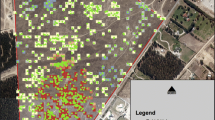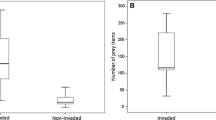Abstract
Australian redback spiders (Latrodectus hasseltii Thorell, 1870) are invasive, opportunistic predators that threaten New Zealand fauna. Initially recorded in Central Otago in 1981, they were observed in 2012 preying on the endemic, nationally endangered Cromwell chafer beetle (Prodontria lewisii Broun, 1904) in the species’ last occupied habitat, the 81 ha Cromwell Chafer Beetle Nature Reserve (CCBNR). We surveyed the redback spider population over the entire reserve in October (spring) and December (summer) 2013, recording web occupants, web condition, and prey caught. During the 5 weeks between surveys, prey caught in half of the recorded spider webs were monitored each week. We estimated a redback population of between 208 and 371 spiders, an average of between 2.57 and 4.58 spiders per hectare within the CCBNR, with maximum web densities ranging between 8.7 and 10.7 webs per hectare. In the final survey in December, 278 P. lewisii cadavers were found in redback spider webs. Redback spiders occupied a large portion of the habitat to which the Cromwell chafer beetles are restricted. Ten of the 26 prey species recorded in webs were native, including McCann’s skink (Oligosoma maccanni); the first record of skink predation by redback spiders in New Zealand.



Similar content being viewed by others
References
Andrade MCB (2003) Risky mate search and male self-sacrifice in redback spiders. Behav Ecol 14:531–538
Baddeley A, Turner R (2005) spatstat: an R package for analyzing spatial point patterns. J Stat Softw 12:1–42
Barratt BIP (2007) Conservation status of Prodontria (Coleoptera: Scarabaeidae) species in New Zealand. J Insect Conserv 11:19–27
Barratt BIP, Ferguson CM, Barton DM (2011) Prodontria lewisii Broun (Coleoptera: Scarabaeidae): population monitoring; laboratory rearing and field establishment. Department of Conservation, Dunedin, New Zealand. RE400/2011/277
Barratt BIP, Ferguson CM, Barton DM, Philip BA (2013) Prodontria lewisii Broun (Coleoptera: Scarabaeidae): population monitoring; laboratory rearing for translocation. Document RE400/2013/492, Report for the Department of Conservation
Bivand R, Lewin-Koh N (2013) maptools: tools for reading and handling spatial objects. http://cran.r-project.org/package=maptools. 6 Aug 2014
Brignall-Theyer ME (1998) Potential vertebrate predators of the Cromwell chafer beetle, Prodontria lewisi. Dissertation, University of Otago
Ferriera SM, McKinlay B (1999) Conservation monitoring of the Cromwell chafer beetle (Prodontria lewisii) between 1986 and 1997. Sci Conserv 123:1–34
Ferriera SM, McKinlay B (2000) Recent vegetation trends at the Cromwell Chafer Beetle Nature Reserve in Central Otago, New Zealand. N Z J Bot 38:235–244
Forster LM, Kavale J (1989) Effects of food deprivation on Latrodectus hasselti Thorell (Araneae: Theridiidae), the Australian redback spider. N Z J Ecol 16:401–408
Garb JE, González A, Gillespie RG (2004) The black widow spider genus Latrodectus (Araneae: Theridiidae): phylogeny, biogeography and invasion history. Mol Phylogenet Evol 31:1127–1142
Hitchmough RA, Hoare JM, Jamieson H, Newman D, Tocher MD, Anderson PJ, Lettink M, Whitaker AH (2010) Conservation status of New Zealand reptiles, 2009. N Z J Zool 37:203
Hódar JA, Sánchez-Piñero F (2002) Feeding habits of the black widow spider Latrodectus lilianae (Araneae: Theridiidae) in an arid zone of south-east Spain. J Zool 257:101–109
Jennings CT, McDaniel IN (1988) Latrodectus hespersus (Araneae: Theridiidae) in Maine. Entomol News 99:37–40
Kabacoff RI (2014) T-tests. http://www.statmethods.net/stats/ttest.html. 14 Nov 2014
Kahle D, Wickham H (2013) ggmap: spatial visualization with ggplot2. R J 5(1):144–161
Kasumovic MM, Andrade MCB (2004) Discrimination of airborne pheromones by mate-searching male Western black widow spiders (Latrodectus hesperus): species- and population-specific responses. Can J Zool 82:1027–1034
Leschen RAB, Marris JWM, Emberson RM, Nunn J, Hitchmough RA, Stringer IAN (2012) The conservation status of New Zealand Coleoptera. N Z Entomol 35:91
Lettink M, Norbury G, Cree A, Seddon PJ, Duncan RP, Schwarz CJ (2010) Removal of introduced predators, but not artificial refuge supplementation, increases skink survival in coastal duneland. Biol Conserv 143:72–77
Matsuse IT, Takeda CM, Kamimura K, Yoshida M (1997) Tolerance of Latrodectus hasseltii (Araneae: Theridiidae) to low temperatures in Japan. Med Entomol Zool 48:117–122
McKinlay B (1997) Changes in Cromwell Terrace vegetation and soils. Conservation Advisory Science Notes No. 163. Department of Conservation, Wellington
Metcalfe DC, Ridgeway PA (2013) A case of web entanglement and apparent predation of the skink Lampropholis delicata (De Vis, 1888) (Sauria: Scincidae: Lygosominae) by the redback spider Latrodectus hasseltii Thorell 1870 (Aranea: Araneomorpha: Theridiidae) in an autochthonous mesic habitat in coastal southeast Australia. Herpetol Notes 6:375–377
Nihei N, Yoshida M, Kaneta H, Shimamaru R, Kobayashi M (2004) Analysis on the dispersal pattern of newly introduced Latrodectus hasseltii (Araneae: Theridiadae) in Japan by spider diagram. J Med Entomol 41:269–276
NIWA (2013) https://www.niwa.co.nz/sites/niwa.co.nz/files/climate_statistics_december_2013.pdf. 25 Feb 2014
Perampaladas K, Stoltz JA, Andrade MCB (2008) Mated redback spider females re-advertise receptivity months after mating. Ethology 114:589–598
R Core Team (2014) R: a language and environment for statistical computing. R Foundation for Statistical Computing, Vienna, Austria. http://www.R-project.org/. 24 July 2014
Raven RJ (1990) Spider predators of reptiles and amphibia. Mem Qld Mus 29:44
Snyder WE, Evans EW (2006) Ecological effects of invasive arthropod generalist predators. Annu Rev Ecol Evol Syst 37:95–122
Vink CJ, Derraik JGB, Phillips CB, Sirvid PJ (2011) The invasive Australian redback spider, Latrodectus hasseltii Thorell 1870 (Araneae: Theridiidae): current and potential distributions, and likely impacts. Biol Invasions 13:1003–1019
Yuen KK (1974) The two-sample trimmed t for unequal population variances. Biometrika 61:165–170
Acknowledgments
Thanks to Gavin Udy and the Alexandra Department of Conservation office who assisted with field work.
Author information
Authors and Affiliations
Corresponding author
Rights and permissions
About this article
Cite this article
Bryan, S.A., van Heezik, Y., Vink, C.J. et al. Invasive redback spiders (Latrodectus hasseltii) threaten an endangered, endemic New Zealand beetle (Prodontria lewisii). J Insect Conserv 19, 1021–1027 (2015). https://doi.org/10.1007/s10841-015-9818-x
Received:
Accepted:
Published:
Issue Date:
DOI: https://doi.org/10.1007/s10841-015-9818-x




